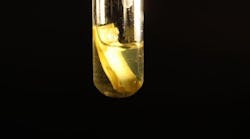Decomposing lignocellulose, the main component of plant biomass, to hydrogen has required a high-temperature gasification process. Now, however, researchers at Cambridge University, Cambridge, U.K., have developed a technique using photocatalytic nanoparticles that produces hydrogen at room temperature. It promises an inexpensive way to generate the gas from waste biomass, they believe.
The technique involves immersing biomass (without any preprocessing) in an alkaline aqueous solution containing semiconducting cadmium sulfide quantum dots and then exposing the system to sunlight (Figure 1). The resulting reactions produce hydrogen and organic chemicals such as formic acid and carbonate from cellulose, hemicellulose and lignin, explain the researchers. The hydrogen is free of materials such as carbon monoxide that would inhibit its use in fuel cells, they add.
The system achieves high rates of H2 evolution. Moreover, its highly alkaline conditions promote the formation of Cd(OH)2 and CdO on the CdS surface, avoiding photocorrosion of the CdS.
Figure 1. Paper immersed in aqueous solution containing cadmium sulfide quantum dots breaks down to form hydrogen when exposed to sunlight. Source: Cambridge University.
More details appear in a recent article in Nature Energy.
“We are currently optimizing the process by varying the catalytic conditions as well as developing improved catalysts. In the near future, we are looking at a broader range of possible substrates such as different types of waste biomass as well as other forms of waste. We are also interested in better controlling the biomass oxidation reaction to generate additional value from organic products such as formic acid instead of CO2,” notes Moritz Kuehnel of the Dept. of Chemistry at Cambridge and joint lead author of the article. “After successful optimization, we will focus on scaling the process from nano-scale (milligrams) to bench demonstrator dimensions (gram scale).
“Optimization work is already under way; studies into scaling-up will commence later this year… we anticipate about a year until we will have a much optimized system and a better idea of the potential substrate scope.”
The researchers also want to replace cadmium sulfide, to avoid the toxicity and waste-management issues it poses. “We are currently testing a number of photocatalysts based on zinc as well as carbon-based materials as photocatalysts instead of cadmium sulfide,” Kuehnel notes, adding the goal is to match the catalytic activity and longevity of CdS.
“In addition, we would like to move away from the highly basic conditions of the current photocatalytic process (10 molar potassium hydroxide) that poses challenges on the reaction container and is also a safety concern.”
“The purity of the generated hydrogen as well as the possibility to operate at small scales and use various types of biomass and waste make it [the system] ideal for small off-grid applications to power fuel cells, for example in remote areas or developing countries,” predicts Kuehnel.
Talks now are underway with a potential commercial partner.
